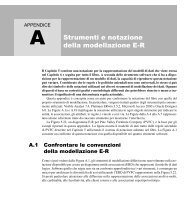Riepilogo di tutto Bode con un PDF chiarissimo
Riepilogo di tutto Bode con un PDF chiarissimo
Riepilogo di tutto Bode con un PDF chiarissimo
Create successful ePaper yourself
Turn your PDF publications into a flip-book with our unique Google optimized e-Paper software.
3.4. LA FORMULA DI BODE 3.4 3<br />
• La f<strong>un</strong>zione <strong>di</strong> trasferimento trascendente<br />
G(s) = e −t0 s<br />
che rappresenta <strong>un</strong> ritardo finito <strong>di</strong> valore t0, non è a fase minima.<br />
• Essendo<br />
G(jω) = e −jωt0 = cos ω t0 − j sen ω t0 ,<br />
la f<strong>un</strong>zione <strong>di</strong> risposta armonica ha modulo identicamente <strong>un</strong>itario e fase<br />
crescente linearmente <strong>con</strong> la frequenza.<br />
• Per ricavare i <strong>di</strong>agrammi <strong>di</strong> <strong>Bode</strong>, si scrive<br />
ln ω<br />
ln G(jω) = α + j β = 0 − j ω t0 = 0 − j t0 e<br />
relazione dalla quale si deduce che il <strong>di</strong>agramma delle fasi ha <strong>un</strong> andamento<br />
esponenziale. Anche in questo caso l’applicazione della formula <strong>di</strong> <strong>Bode</strong><br />
avrebbe <strong>con</strong>dotto ad <strong>un</strong> risultato errato (β = 0).<br />
R. Zanasi, R. Morselli - Controlli Automatici - 2005/06 3. ANALISI ARMONICA



